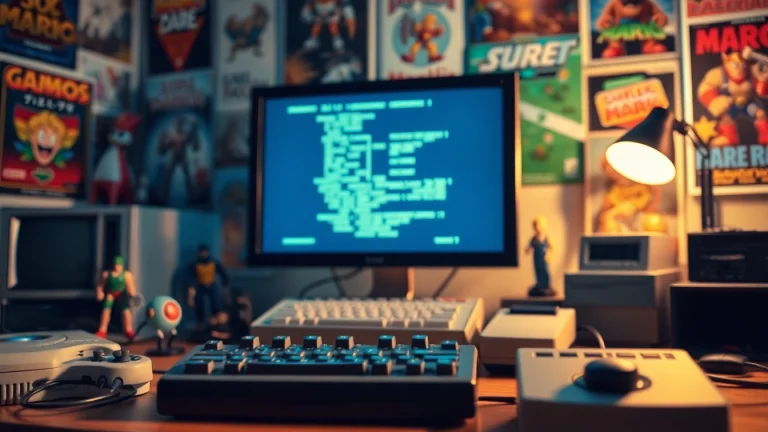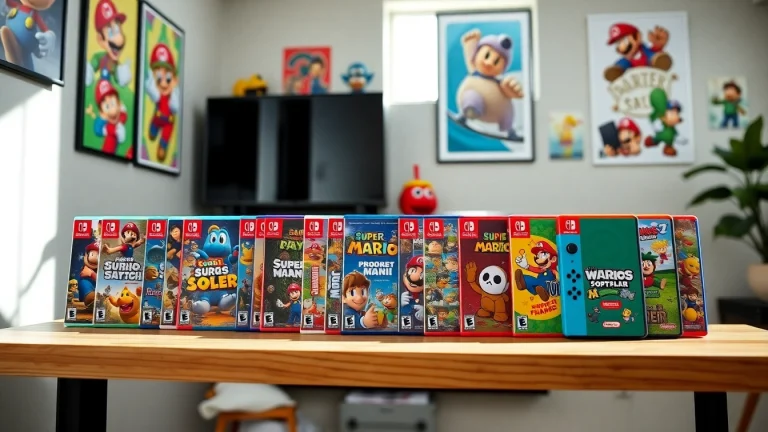
Mastering Strategy and Tactics in Dune 2 Game: A Guide to Victory
Introduction to the Dune 2 Game
The dune 2 game is a pivotal title in the realm of real-time strategy (RTS) games, having set benchmarks for future titles in its genre. Released in 1992 by Westwood Studios and published by Virgin Games, this game was not just a mere sequel but an evolution of the real-time strategy experience. With its intricate gameplay mechanics and immersive storytelling, Dune II\
Overview of Gameplay Mechanics
The gameplay of Dune 2 is centered on strategizing and resource management. Players select a faction among three—House Atreides, House Harkonnen, and House Ordos—each offering distinct abilities and units. The primary objective is to harvest spice, the vital resource central to the game’s economy, and utilize it to build structures, create units, and conquer enemy territories.
With a top-down perspective, the game allows players to navigate the expansive desert landscape of Arrakis while engaging in tactical warfare. Each action, whether gathering spice or launching an assault, requires careful consideration and planning, adding layers of complexity to each mission. Communication and timing are crucial, making Dune II a true test of strategic thinking.
Historical Context and Impact
Dune II emerged during a transitional period in the gaming industry when the transition from 2D games to more sophisticated interactive experiences was just beginning. Its mechanics influenced countless subsequent titles, setting the stage for iconic games such as Command & Conquer and StarCraft. The ability to control units in real-time, build bases, and engage in resource management became a standard that many games sought to emulate.
Furthermore, the adaptation of Frank Herbert’s Dune universe into a strategy game allowed players to explore a rich narrative backdrop, including the political intrigue and epic battles present in the source material. Despite being released over three decades ago, the game retains a dedicated fan base, sparking ongoing discussions and analyses within gaming communities.
Understanding Game Objectives
The core objective in Dune 2 revolves around controlling and harvesting spice, which serves as the currency for unit production and technological upgrades. Players must establish their base, defend against enemy attacks, and expand their territory. Success is determined not just by resource collection but also by the strategic deployment of forces and the ability to outmaneuver opponents.
In each campaign, players face challenges that require adaptability. Missions often introduce new factions, enemy units, or environmental hazards, pushing players to implement different strategies. The game’s structure encourages replayability, as players can experiment with various factions, each requiring unique approaches to succeed.
Factions and Their Unique Abilities
In the Dune 2 game, players can choose from three unique factions, each with distinctive strengths, weaknesses, and playstyles. Understanding these differences is paramount to leveraging their strengths effectively and overcoming the challenges posed by opponents.
House Atreides: Strengths and Strategies
House Atreides is characterized by their diplomatic approach and advancing technology. Known for their well-rounded units, Atreides excels in defensive strategies, relying on a mix of infantry and advanced vehicles. Their exclusive unit, the Sonic Tank, can incapacitate enemy units, serving as a game-changer in combat.
Effective usage of House Atreides involves securing defensive positions early on while gradually pushing against enemy territories. Players should focus on building alliances and employing hit-and-run tactics to disrupt enemy operations. Atreides players must also prioritize upgrading their technology to ensure they maintain an edge in production and equipment.
House Harkonnen: Recruitment and Tactics
House Harkonnen boasts formidable strength and aggressive tactics, favoring a “brute force” style of play. With tougher units and structures, Harkonnen players can unleash devastating assaults on opponents. Their standout unit, the Devastator, is a powerful addition to their arsenal that can wreak havoc on enemy lines.
Successful Harkonnen gameplay requires a focus on overwhelming the opposition through sheer force. Players should aim to recruit and produce units quickly, utilizing their strength to take the fight to the enemy before they can mount a proper defense. Decisive attacks can flip the momentum of battles, making Harkonnen a fearsome choice for players who prefer high-stakes aggression.
House Ordos: Unique Units and Strategies
House Ordos, introduced later in the game, offers a unique spin on gameplay with their stealth-focused tactics. Their units, such as the Raider, utilize deception and surprise attacks to outmaneuver and flank opponents. Ordos gameplay rewards strategic positioning and timing over direct confrontation, encouraging players to think creatively when planning assaults.
To excel with House Ordos, players should leverage their stealth capabilities while gathering intel on enemy movements. Engaging in guerrilla warfare can help harass enemies and disrupt their resource gathering, allowing players to gain a competitive edge. Mastering the operational tempo is central to exploiting House Ordos’ strengths effectively.
Strategic Resource Management in Dune 2 Game
Resource management is a core component of the Dune 2 game, where key resources directly influence a player’s capacity to build, fortify, and expand their empire. Efficient management leads not only to survival but ultimately to domination over rival factions.
The Importance of Spice Control
Spice is the linchpin of gameplay in Dune II; controlling spice fields can dictate the flow of the game. Harvesting spice is not just about collecting it but also about timing and positioning. Players must establish refineries and harvesters strategically to maximize output while ensuring that they are protected from enemy raids.
Strategic players will often scout for spice fields near enemies to disrupt their operations while ensuring their supply lines are secure. Controlling multiple spice fields can create a significant economic advantage, allowing for faster troop production and upgrades.
Building and Upgrading Structures
Establishing and upgrading structures is vital for maintaining a steady production of units and fortifying defenses. Players must balance their resource allocation between immediate needs and long-term investments, such as upgrading technology or expanding their base.
Structuring a base efficiently often requires thoughtful planning; players should prioritize key defensive structures while ensuring that production facilities are easily accessible. Upgrades can enhance unit capabilities and improve resource harvesting, dramatically affecting a player’s capacity to wage war effectively.
Managing Resources Efficiently
Efficient resource management includes not only spice but also unit production capabilities. Players must decide when to invest in defensive units, offensive capabilities, and upgrades. A well-balanced strategy will typically involve creating a mix of different types of units to respond flexibly to enemy movements.
Furthermore, understanding when to transition from defense to offense is key. Players should track their enemies’ resource levels and weaknesses, identifying optimal moments to launch attacks. Effective resource management encompasses foresight, ensuring that a player is always prepared for the evolving tactics of their adversaries.
Tactical Warfare: Combat Strategies
Combat serves as the climactic aspect of the Dune 2 game, dripping with strategic importance. Understanding how to effectively engage in warfare can mean the difference between conquest and defeat. Tactics extend beyond brute force, requiring players to be thoughtful in their engagements.
Effective Use of Units in Battle
Understanding each unit’s strengths and weaknesses in combat is paramount to exploited strategies. Players must leverage unit advantages, such as range, armor, and special abilities. Pairing units effectively can produce devastating combinations; for instance, using infantry to distract while artillery units deliver damage from a distance can turn the tide of battle.
Additionally, terrain plays an integral role, with higher ground or cover providing defensive bonuses. Players should always seek opportunities to position their forces advantageously based on the battlefield layout, enhancing their chances of winning engagements.
Defensive Strategies and Base Protection
Investing in defensive strategies is essential to protect one’s resources and units from enemy incursions. Effective base design should include choke points, fortifications, and a clear path for retreating units. Players should prioritize placing turrets and defensive structures in areas that guard key locations within their base.
Moreover, maintaining a reserve of units for quick deployment can help counter surprise attacks. Establishing early warning systems, such as scout units, can provide valuable intel on approaching enemies, allowing for better-prepared defenses.
Adapting to Opponent Strategies
Being able to adapt strategies based on the opponent’s actions is central in Dune II’s warfare. Players might need to shift from a defensive approach to offensive strikes if the enemy seems to overextend themselves. Keeping an eye on enemy production and unit movements will provide insights into their strategies, enabling tailored responses.
Additionally, countering enemy tactics requires a keen understanding of their faction’s strengths and weaknesses. Adjusting production to create specific units that excel against the opponent’s army composition can provide the necessary edge to turn the tide of battle.
Community and Legacy of Dune 2 Game
Throughout the years, the Dune 2 game has fostered a vibrant community that celebrates its timeless charm and engaging gameplay. The game’s legacy stretches beyond mere nostalgia, influencing modern titles and retaining a dedicated fanbase.
Fandom and Player Communities
The community surrounding Dune II remains active, with enthusiasts sharing strategies, conducting modding projects, and even creating fan-made remakes. Online forums and social media groups keep the spirit of the game alive, allowing fans to debate strategies, tactics, and the game’s historical significance.
Players often organize events and competitions, celebrating the game’s mechanics while introducing new players to its challenges and delights. This communal engagement fosters a supportive environment where players can share their love for the classic title.
Modern Remakes and Inspirations
In recent years, various projects have sought to breathe new life into Dune II, with remakes and adaptations that balance nostalgia with modern sensibilities. These projects often strive to update the graphics and mechanics while retaining the core essence of the original gameplay.
Some developers have drawn inspiration from Dune II to create new RTS experiences, acknowledging its lasting impact on the genre. Such titles have implemented similar mechanics while introducing fresh narratives and settings, showcasing the foundational strides made by the original game.
The Enduring Influence of Dune 2 Game
The influence of the Dune 2 game extends far and wide throughout the landscape of video games. It is credited with establishing the blueprint for real-time strategy games, shaping how resource management and tactical warfare are approached in contemporary titles.
As players continue to engage with Dune II, whether through original play or modern adaptations, its legacy remains firmly entrenched in the hearts of both veteran gamers and newcomers alike. The lessons derived from its gameplay continue to resonate, ensuring that the game endures as a benchmark for strategy gaming excellence.


